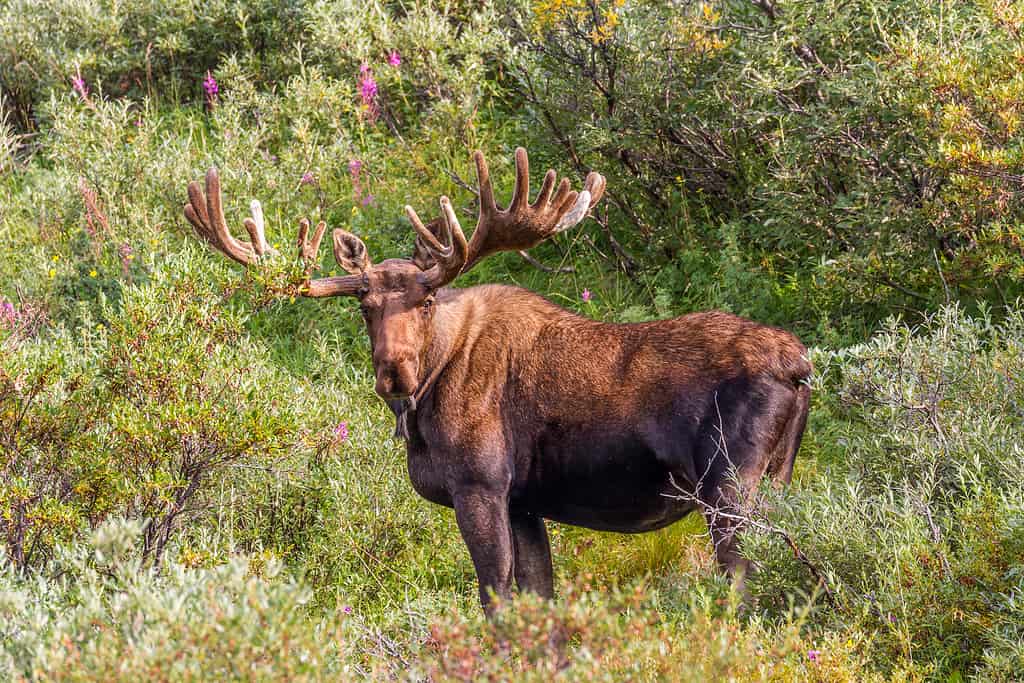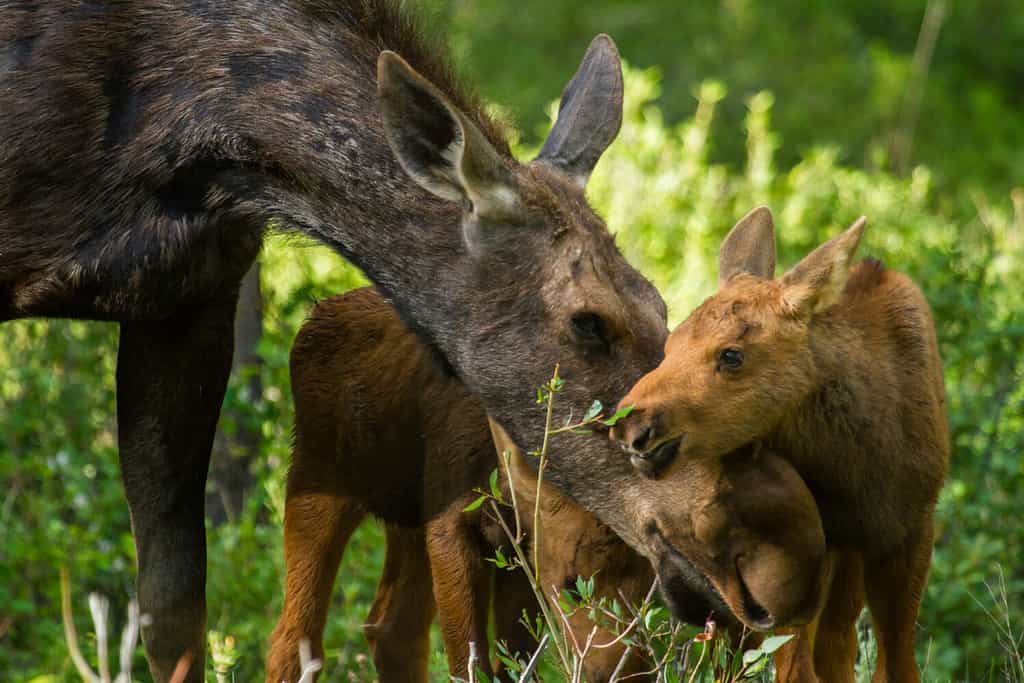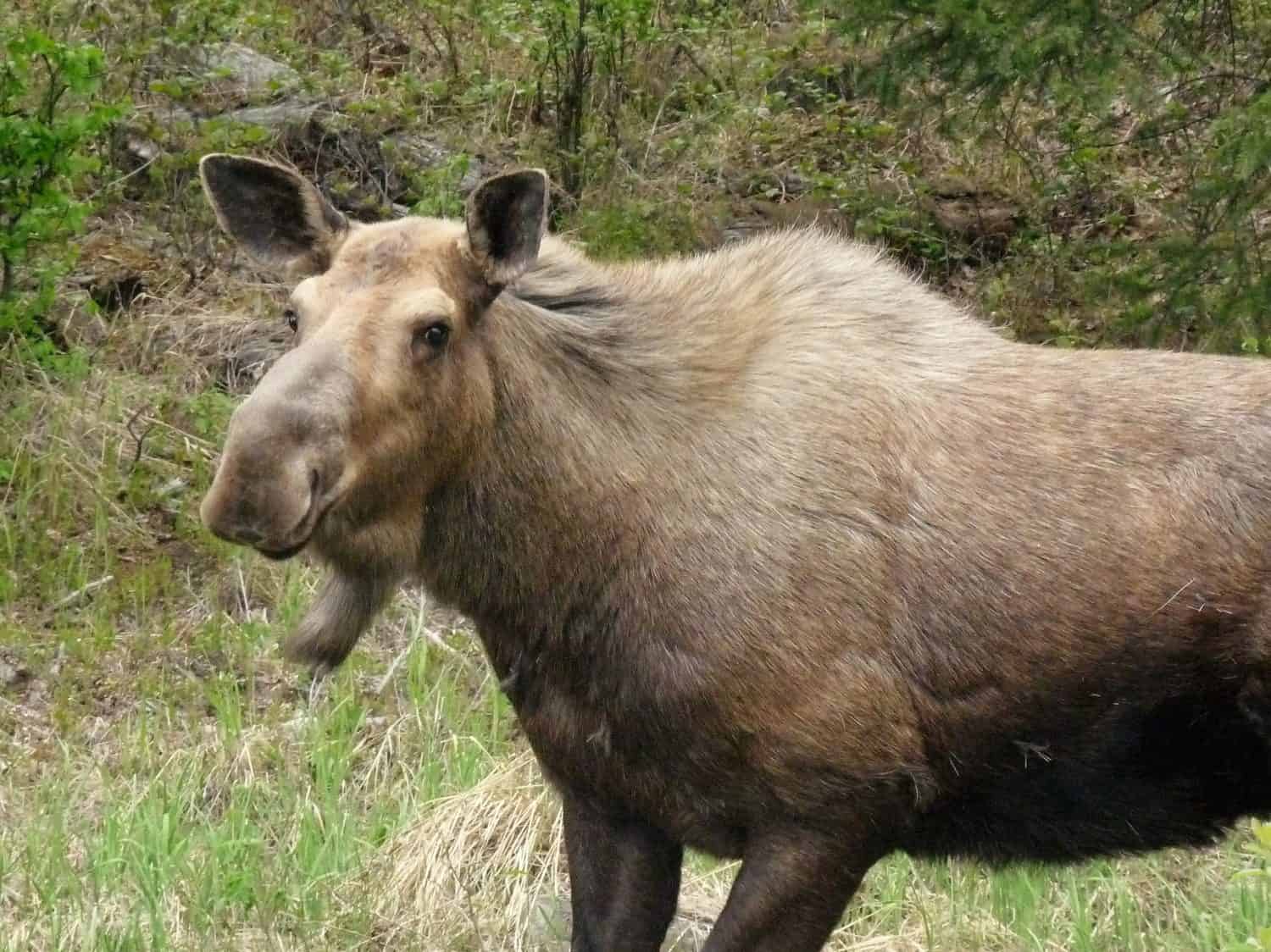Imagine walking through the forests and hearing a moose call out. Known as elk in Europe, moose have some of the strangest vocalizations around. From bellows to grunts, these long-legged mammals are great at communicating. They have special calls to attract mates, ward off threats, and call their young. It’s time to explore the many sounds of the moose. Follow along as we uncover all of the noises male and female moose make, and why.
What Kind of Sound Does a Moose Make?
Moose make all sorts of sounds including roars, grunts, snorts, croaks, and bellows that can be heard miles away. The famously loud bellows help bulls attract a mate. Grunts are for up-close encounters with potential mates, and roars are usually reserved for territorial disputes. Females, or cows, are also vocal, making loud drawn-out moans, wails, and moos.
How Far Away Can Moose Calls Be Heard?

A moose call can carry for miles throughout the forest.
©JacobLoyacano/Shutterstock.com
A moose call can carry around 2 to 6 miles. Some research suggests the shape of a bull’s antlers helps them hear long distances. The directionally sensitive antlers help guide them toward a mate.
Male Moose Calls
Let’s look at the sounds bulls or male moose can make. Some of the noises are to attract mates, while others are angry sounds telling others to stay away.
Here are some of the sounds male moose make:
- Happy grunts
- Angry grunts
- Roars
- Bellows
- Snort
- Croak
- Bark
Along with vocalizations, moose also use scents, body language, and antlers to communicate.
Bellows
The primary rut cycle happens near the end of September and early October. Around this time you can start hearing moose bellows echo through the forests. These calls help attract potential mates. Bulls are usually solitary, but will sometimes gather together during mating season.
Happy Grunt vs. Angry Grunt
Grunts can also related to mating season, and they usually happen once a female is within the site. This sound is usually happy, one that says, “Let’s mate”. Bulls wait until their very close to a cow they like to start grunting. Because of this, it’s unlikely you’ll ever hear the grunts live in the wild. If you hear a moose call in the wild, it’ll probably be a bellow or roar.
A grunt can also be an angry moose sound. If the moose hears or smells something he doesn’t like he might start making hiccups like grunts. They’ll usually do this for a few minutes, waiting a few seconds between grunts. Lick-lipping is a behavior that usually accompanies angry moose grunts. And if things get heated, they might even roar.
Roar
Thanks to the shape of their skulls, moose can make a loud intimidating roar. It doesn’t sound like a lion, but more like an infuriated cow. It’s the most aggressive sound a male or female moose will make.
Why roar? It’s usually to ward off a perceived threat. Moose are mostly solitary animals, so they don’t like it when another male is hanging out in their territory. A bull will roar at another male to send a loud and clear message to go away. After taking a deep breath in they force the air out through their huge nostrils.
Before they roar, a moose will probably snort. Similar to a deer, bulls, and cows snort to ward off threats. They usually reserve snorts for low-level threats or things they find annoying. If a moose ever snorts at you it wants you to go away.
Female Moose Calls
Female moose have their own special ways of communicating during mating season. They also have special sounds reserved for communicating with their calves.
Here are some of the sounds female moose make:
- Moan
- High-pitched long call
- Growl
- Bark
- Snort
- Grunt
Cows have a muffled, pained-sounding moan. Ending on a low exhausted note, they use this call when they’re looking for a mate. The moan sounds a bit like “EEEEEEERRR-UGH”. There’s a long “E” sound, and the “UGH” sound is quick and sudden. This call can last 5 seconds or longer.
High-Pitched Moan
The opposite of this call is their protest moan or high-pitched long call. Females use this call if a young or small bull tries to mate with them. The long, high-pitched call tells the dominant bull to come and stop the inexperienced male.
Calf Calling
Cows use a high-pitched noise when calling their young. These types of calls help keep the young close by so they’re not eaten by bears or wolves. If the calf is close by the mother may just grunt to gather them.
Growling
If a mother moose loses track of her calf, she’ll start making a growling sound. They also growl, bark, snort, or roar when there’s a nearby threat. If the need arises, moose can take off at fast speeds, galloping away or towards a threat.
Baby Moose Sounds

Baby moose, or calves, have a high-pitched wail for the first few days of life.
©Green Mountain Exposure/Shutterstock.com
A baby moose, or calf has a lot to say. Calling out with a high-pitched wail, they’re quick to let their mother know if they’re scared or hungry. The pitch only stays high for a few days after birth. Then it lowers a bit, making them almost sound like a human baby.
Alaskan Moose Has a Protest Moan

Alaskan female moose have a special protest moan.
©BobZuke/Shutterstock.com
Female moose have a moan they use to make males fight. Not all of the males though, just the smaller ones.
Alaskan moose have a dominant bull mating system. He leads bull herds, and courts, and hopes to mate with all of the females in his territory. Females, hoping to have a larger mate, are on board with this system. But sometimes smaller males try to mate with the cows before a larger bull has a chance.
Research suggests females use a protest moan to avoid attention from smaller males. If a smaller moose tries to mate with the female cries out frequently. These moans cause the males to be more aggressive with each other, and fights break out. This distraction opens up the cow’s opportunities for landing the lead bull.
The photo featured at the top of this post is © ArtBBNV/Shutterstock.com
Thank you for reading! Have some feedback for us? Contact the AZ Animals editorial team.






